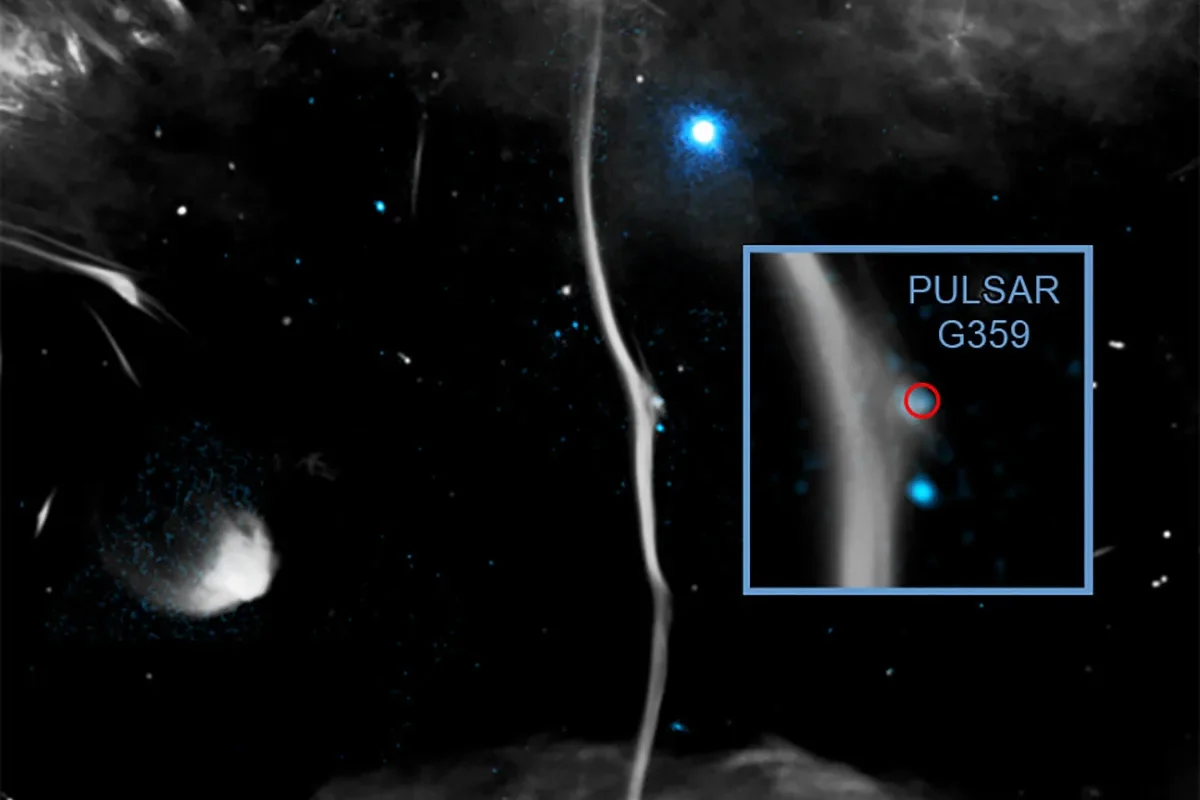When a Star Becomes a Cosmic Bullet
After a supernova explosion, a star’s core collapses into a neutron star—an object so dense that a teaspoon of its matter would weigh billions of tons.
These stars often spin rapidly and emit beams of radiation, creating what astronomers call a pulsar.
Sometimes the supernova blast is uneven, kicking the pulsar into space at unimaginable speeds.
That’s what happened with G359—a stellar core shot out like a bullet through the Milky Way’s center at over 3 million kilometers per hour.
Collision With “The Snake”
On its journey, the pulsar collided with a strange structure called G359.1–0.2, known as “The Snake.”
It’s a thin but extremely long magnetic filament, stretching over 200 light-years near the Galactic center.
This filament acts like a cosmic cable of charged particles and magnetic fields that glow in radio waves.
When the pulsar struck it, a massive energy burst occurred.
The magnetic field twisted and broke, forming a visible kink where the structure bent sharply.
At that point, scientists detected intense X-ray and radio emissions, evidence of a shockwave tearing through the filament.
How It Was Discovered
Astronomers used NASA’s Chandra X-ray Observatory, along with the MeerKAT and VLA radio telescopes, to study this region.
They found a compact X-ray and radio source exactly where “The Snake” bends.
Its very steep spectrum (–2.7) is typical of a pulsar.
Around that source lies diffuse emission—a faint glow from electrons and positrons accelerated during the impact.
These particles spiral through the magnetic field, continuing to shine thousands of years later.
Traces of Energy
The impact site still glows in X-rays and radio waves, long after the collision.
It’s like a frozen explosion in space, where the released energy keeps flowing through the magnetic structure.
The pulsar has since moved farther away, traveling at around 800 kilometers per second, making it one of the fastest objects in the Milky Way.
Why This Event Is Unique
This is the first time scientists have observed a pulsar directly colliding with a magnetic filament.
It allows researchers to study how magnetic fields break and rebuild, and how high-energy particles—the same ones that form cosmic rays—are created.
The encounter between pulsar G359 and “The Snake” helps us better understand the chaotic heart of our Galaxy, home to the Sagittarius A* black hole, intense magnetic forces, and swirling plasma clouds.
Scientific Background
According to 2024 research (Yusef-Zadeh et al., MNRAS 530:254–268), pulsar G359.13142-0.20005 is moving at up to 1,000 km/s and likely plowed through “The Snake”, triggering a magnetic shockwave and particle outflow.
X-ray observations suggest the impact occurred about 10,000 years ago, yet its effects remain visible today.
Conclusion
At pulsar G359, we witness how a dead star can still reshape the fabric of space.
A tiny object only 20 kilometers wide managed to distort a magnetic structure hundreds of light-years long.
This event reminds us that the Universe is alive, dynamic, and full of forces far beyond human imagination.



